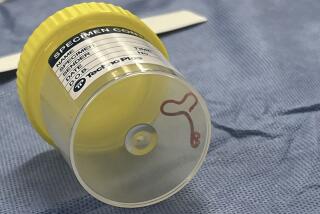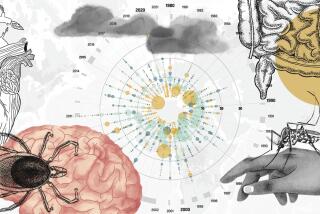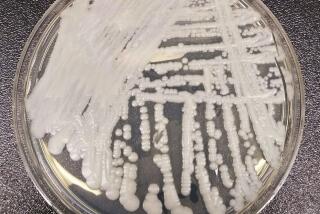Science / Medicine : Death of a Disease : Global campaign aims to make parasitic guinea worm second illness eradicated from Earth.
- Share via
ABEOKUTA, Nigeria — Stooped and wizened, Dawda Agdegbe easily looked twice his 40 years as he explained why he had not worked his yam field for 14 months, leaving it to become fallow and overgrown with weeds.
“When the disease starts, you can’t work,” he said, exhibiting his scarred and blistered legs. “It causes pain throughout the body and you can’t walk.”
Next to him on a splintered bench at the rear of a dark schoolhouse, a half-dozen of his neighbors sat quietly--farmers, women, children. All showed some stage of the disease that Agdegbe described: guinea worm.
From the legs of some, the threadlike white parasite was already emerging, in the final painful and debilitating stage of the malady. Others showed high round blisters or the scars of a dozen earlier infections.
Today this disease, known by its scientific term dracunculiasis, affects 10 million people a year in parts of India, Pakistan, and a belt of 16 African countries.
It is rarely fatal, but its toll should not be underestimated. Its outbreaks tend to peak during harvest season, so acres of crops lie rotting in the fields because farmers are crippled for half the year. In Nigeria, one of the worst-affected lands, an estimated $20 million a year is lost this way in rice-growing districts alone, in areas with a population of only 1.6 million. The total cost across the agricultural spectrum is much higher.
During the annual outbreaks, Nigerian district officials can count a 100% drop in school attendance among children from villages with endemic dracunculiasis. In some places, people are infected repeatedly over their lifetimes, year after year, from infancy to old age. In such cases the toxins excreted by the parasite eventually produce a permanent arthritis-like disability.
Yet guinea worm may be closer to extermination than any other of the world’s parasites. A group of Western donors supervised by the United Nations and Global 2000, a private development agency organized by former President Jimmy Carter, has begun a campaign to make dracunculiasis the second disease, after smallpox, to be completely eradicated from the Earth.
At a recent conference in the Nigerian capital of Lagos, the donor agencies pledged $9.4 million for next year, the first step toward the goal of extermination by the year 1995.
“This clearly is an end-of-the-road disease,” said Dr. William H. Foege, a former official of the Atlanta-based Centers for Disease Control. He participated in the smallpox eradication campaign in Africa and is assisting with the guinea worm program.
The guinea worm program represents an attempt, uncommon in the developing world, to aim at a health goal that is attainable. The extermination of many diseases more lethal would require reserves of political will, stability, money and manpower that are simply beyond the capacity of the Third World, even with millions of dollars in assistance from developed countries.
“It would be nice to get rid of cholera and typhus, but we can’t,” said Peter Bourne, a former Carter Administration aide who now heads a Washington nonprofit development group called Global Water.
Some anti-disease campaigns can also aggravate conditions if they do not proceed uninterruptedly to a decisive conclusion, something often very difficult amid the Third World’s political and economic instability.
A half-finished malaria eradication campaign mounted by the French in the 1970s in Madagascar, for instance, is now being blamed for a resurgence in fatal cases of that disease in the island’s central highlands. World Health Organization inspectors believe the campaign initially was so effective that local residents lost their natural immunity to the malaria parasite, which they normally acquire from repeated low-level infection. As malaria has crept back into the region over the past two or three years, it has caused at least 50,000 deaths, and possibly as many as 100,000, among the overly vulnerable population.
A similar program to eliminate bovine sleeping sickness in Zimbabwe cost the lives of an estimated 1 million head of unprotected cattle when the program was halted during the Zimbabwean civil war of the late 1970s and early 1980s.
Guinea worm disease carries no such risk, scientists say. Infection by the parasite, no matter how frequent, does not create immunity, so people freed of the disease are not more menaced if it returns. There is no known technical obstacle to its eradication; chemical treatments to clear the parasite from water sources are available, and cheaper mechanical means of cleaning drinking water are common.
“It’s easy to break the life cycle of this parasite,” Bourne said.
The life cycle harbors no particular mysteries. Guinea worm can be communicated to humans only one way: drinking infected water. The worm’s larvae enter the body through the alimentary canal and grow into threadlike white worms of as much as eight to 10 inches in length. Over a period of six months to a year they make a painful migration within the body toward the skin of the legs, where they eventually become visible as large blisters or show their serpentine form under the surface.
Presently, like the creature in the movie “Alien,” they burst through the skin. At that point, victims can begin to extract them by winding them around a stick or pencil, tugging them out painfully, a fraction of an inch a day.
There is no cure once a person is infected; only the parasite’s inexorable creep toward the skin can rid the body of the affliction. Once the life cycle of the parasite is complete and the worm leaves the body--a matter of perhaps several months--the person is rid of the infection. But reinfection is a major problem.
Victims driven to seek relief from the burning and itching of their blisters stand in the ponds or streams that provide their villages with drinking water; that causes the blisters to burst, sending worm eggs into the water and beginning the cycle of pollution and infection all over again.
Thus the obvious remedy: Keep infected people out of the ponds, provide capped and pumped wells for drinking water, teach rural villagers to strain or boil water before using it.
This is a disease for which low-tech solutions are ideal. Unlike rabies, which kills 52,000 people a year and whose wild-animal carriers are impossible to vaccinate, guinea worm has no animal host except man. Unlike measles, which kills 2 million uninoculated children a year, guinea worm requires no vaccine. Unlike syphilis or AIDS, fighting it demands no radical change in social habits.
“In theory, this should be so much easier to eliminate than smallpox,” Foege said. “With smallpox, we had to identify every last case and treat it. There was no alternative to dealing with individuals. With guinea worm, we just have to treat the water supply in each affected village.”
One program of education and well-drilling in a single village in the West African nation of Togo, according to Global 2000, reduced the incidence of dracunculiasis from 928 cases in 1981 to zero last year.
Something else that gives the disease-hunters hope is the historical record on guinea worm. Dracunculiasis was once known all over the world. It was so familiar in ancient Greece that it may have inspired the caduceus, the familiar symbol of medical science in the form of two serpents entwining a winged staff. Some believe the serpents represent guinea worms, and the staff the stick around which a worm is wound so its victim can tug it out of his or her skin.
The Greeks and Turks wiped out the disease centuries ago, and its range has been steadily shrinking. Dracunculiasis was exterminated from Russia in the 1920s and from Iran in the 1960s. India’s campaign has reduced the number of known cases to just over 10,000 last year from a peak of 45,000 in 1983.
That leaves only a belt of 16 countries across West and Central Africa where measureable progress is absent. Here the disease thrives on ignorance and neediness. Villagers use and reuse infected water sources mostly because they have not learned how easily guinea worm can be prevented.
“We’re just banking on luck,” said the farmer Agdegbe, noting that his villagers apply a natural remedy of black soap and onions to soothe the fiery discomfort of the disease, but do not habitually take any precautions with their water.
Also contributing to the disease’s persistence is its confinement to the poorest and most rural districts of the African countries, which are unknown territory to the educated classes of government and bureaucracy.
Ex-President Carter, meeting with a group of Nigerian journalists during the Global 2000 conference, asked how many of them had even heard of guinea worm three years ago. Not a hand was raised.
“Guinea worm is not a problem which the elite usually see,” said Dr. Olikoye Ransome-Kuti, the Nigerian minister of health. “When Nigerians discovered there were 1 million cases in their country, they were surprised. They didn’t even know it existed.”
GUINEA WORM: HOW AND WHERE THIS CRIPPLING DISEASE STRIKES
Guinea worm, known by its scientific term dracunculiasis, affects 10 million people a year in parts of India, Pakistan and a belt of 16 African countries.
Guinea worm is communicated to humans through drinking water infected with the microscopic crustacean Cyclops , which carry the worm’s larvae. The larvae enter the body through the alimentary canal, and grow into threadlike white worms of as much as eight to 10 inches in length. Over a period of six months to a year they make a painful migration within the body toward the skin of the legs, where they eventually become visible as large blisters.
The worms burst through the skin and the victims can extract them by winding them around a stick or pencil, tugging them out painfully, a fraction of an inch a day.
Dracunculiasis was once known all over the world. It was so familiar in ancient Greece that it may have inspired the caduceus, the familiar symbol of medical science in the form of two serpents entwining a winged staff. Some believe the serpents represent guinea worms, and the staff the stick around which a worm is wound.






